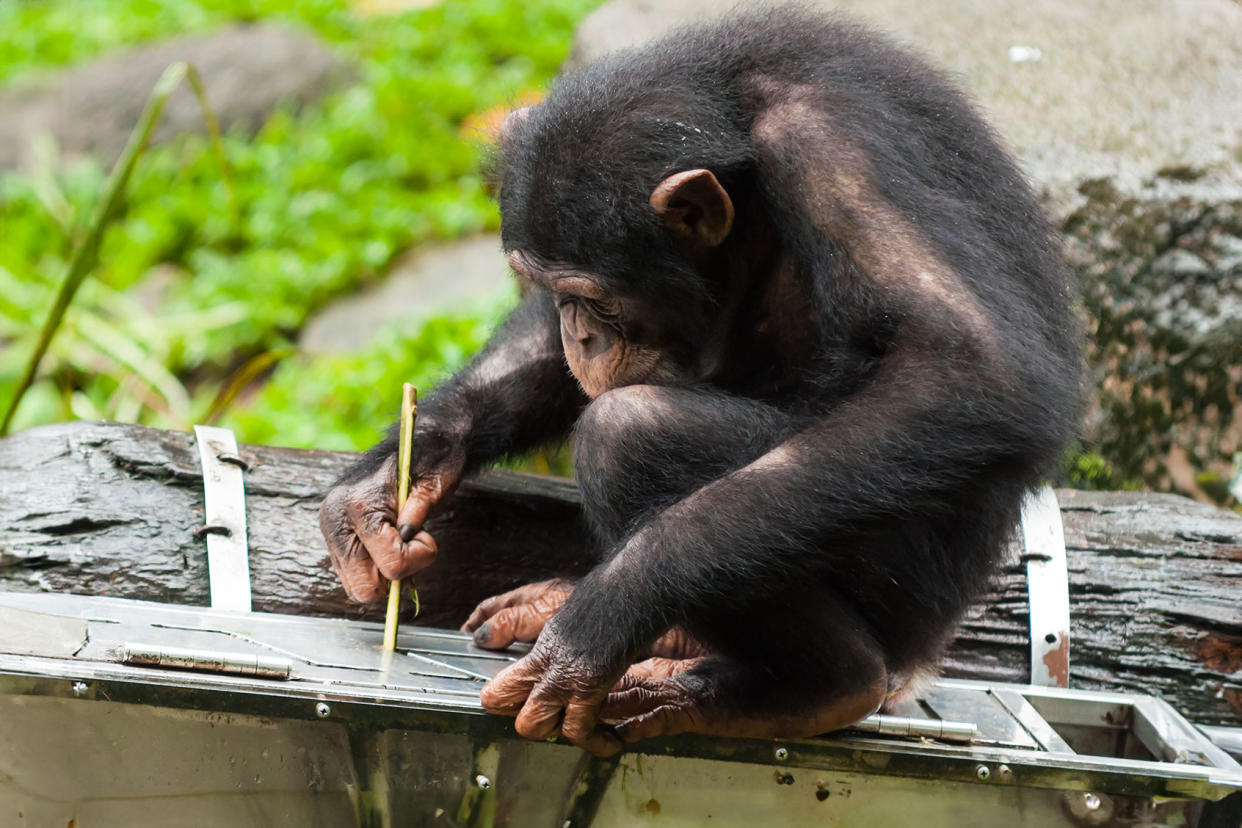Chimps continue learning tool use even as adults, study finds

Many younger people know the pain of trying to teach an older person how to print a PDF or navigate the internet. But, of course, some people keep with the times and still learn how to use new tools later in life. Does the same hold true for other primates? The answer seems to be yes, at least when it comes to chimpanzees (Pan troglodytes).
Scientists in the African country of Côte d’Ivoire spent seven-and-a-half years quietly recording 70 wild chimpanzees of all ages. They did so because, while researchers have known for decades that chimpanzees can use tools, they did not know whether these primates are like humans in being able to continue learning throughout their lifetimes.
According to the recent study published in the journal PLOS Biology, the wild western chimpanzees were able to develop their use of stick tools into adulthood.
The chimpanzees, who were studied in their natural home at Taï National Park, became increasingly adept as they aged at utilizing various finger grips to handle the sticks they used for retrieving food. After beginning to develop their dexterity by the age of six, these animals were usually not fully capable of removing insects from hard-to-reach places or adjusting their grip when necessary until they reached the age of 15. Scientists conclude this means that the chimpanzees have to keep learning new technological skills as they grow older; it is not simply a question of physical aptitude.
“In wild chimpanzees, the intricacies of tool use learning continue into adulthood," the authors said in a statement. "This pattern supports ideas that large brains across hominids allow continued learning through the first two decades of life.”
At this point, the next step for researchers is to learn why chimpanzees do not become even more skilled in their tool use than they currently are.
"Whether the limiting factor preventing more tool use and manufacture in chimpanzees populations is cognitive capacity in specific domains (e.g., action planning) or is rather due to limited exposure to role models to acquire culture cumulatively remains to be examined," the authors write.
Studying tool use is one of the best ways to understand the evolution of intelligence. Other species demonstrate using tools in various flexible ways. In fact, humans' ability to use tools has been argued to be one of the most fundamental differences between us and other animals. The authors point out that New Caledonian crows, Goffin's cockatoos, woodpecker finches, bearded capuchins, bottlenose dolphins, orangutans, gorillas and sea otters can also use tools flexibly. At the same time, they explain that chimpanzees are one of the only species where the ability to flexibly use tools is "regularly observed across individuals, populations, tool materials and contexts."
This is also true for humans, and because chimpanzees are one of our closest living relatives, studying how chimpanzees use tools can ultimately illuminate how humans developed those same skills.
Want more health and science stories in your inbox? Subscribe to Salon's weekly newsletter Lab Notes.
"While significant differences exist between the hand anatomy of chimpanzees and humans, with the former having long digits and small and weak thumb considered inoperant in precise handling, chimpanzees employ all hand grips described in humans, including the pad-to-pad precision grip, a complex hand grip long thought to be unique to humans," the authors write.
This study is only the latest in a long series of papers that repeatedly amaze humans with the intelligence of their primate relatives. A paper this month in the journal Nature revealed that an orangutan had been filmed grinding up plant matter and applying it to a facial wound. This may have been the first documented case of a wild animal treating its own wound with medicine. The researchers wrote that "this possibly innovative behavior presents the first systematically documented case of active wound treatment with a plant species know to contain biologically active substances by a wild animal and provides new insights into the origins of human wound care."
Other recent studies have focused specifically on chimpanzee intelligence. In a study published for the journal Nature Communications, scientists placed fake snakes among wild chimpanzees in Uganda to monitor their vocalizations as they reacted. They observed that the chimpanzees produced a "waa-bark" sound in order to recruit other chimpanzees to deal with the "snake," while if they were surprised they produced a sound called an "alarm-huus." In the process, the chimpanzees effectively created the equivalent of syllables and words to form sentences that communicated complex ideas — also known as language.
"We propose the 'alarm-huu + waa-bark' represents a compositional syntactic-like structure, where the meaning of the call combination is derived from the meaning of its parts," the authors explain in their study.
Another recent study, this one published in the journal Communications Biology, also studied a group of chimpanzees at Taï National Park. This time the scientists looked at 46 animals, analyzing the sounds they produced in order to better understand how they communicate.
"Chimpanzees produced 390 unique vocal sequences," the scientists wrote. "Most vocal units emitted singly were also emitted in two-unit sequences (bigrams), which in turn were embedded into three-unit sequences (trigrams)."
As in the study on chimpanzee tool use, the study on their complex vocalizations benefited immensely from the fact that it was performed on wild animals. As the authors of the tool study observe, the greatest challenge in understanding chimpanzees it is that so difficult to obtain sufficient records of their activities while they are still in the wild. Given that chimpanzees are endangered as a result of human activity, the opportunities to observe them in the wild are sparse and increasingly hard to come by.
"Studies examining how chimpanzee tool use manipulative skills develop across their lifetime, especially in the wild, are rare," the scientists write. "This gap in the literature impedes our understanding of the motor and cognitive skills that may underlie chimpanzee natural tool use behavior."

